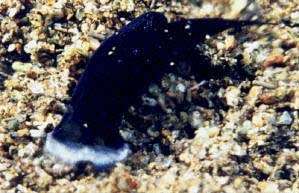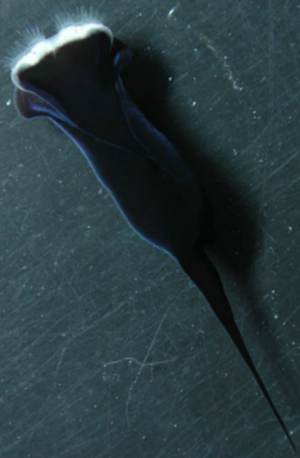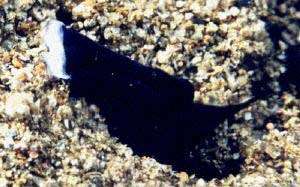
Chelidonura sp. 1.
Order: CEPHALASPIDEA
Family: Aglajidae
PHOTO
Negros, Philippines, October 1998. Size: less than 1cm, Depth 15m. PHOTO: Erwin Koehler
•See message below.
•See Lindsay Warren's message about C. sandrana [Photos 0776, 0777].
Rudman, W.B., 1999 (January 19) Chelidonura sp. 1. [In] Sea Slug Forum. Australian Museum, Sydney. Available from http://www.seaslugforum.net/find/chelsp1
Related messages
Black Chelidonura from Lizard island
January 25, 2003
From: Nils Anthes

Hi Bill,
Following on from my earlier message, here is some more information on Chelidonura sandrana and the black 'species' which we have found in separate populations, at Lizard Island.
Yesterday [20 January 2003] we randomly collected 37 animals at a site were only the black Chelidonura " occurs. Today we made some detailed comparisons with C. sandrana and we assume that we are looking at a different species. I attach a picture (made with a strong flash; overexposed because of the black background) . I will list some reasons why we believe this is a distinct species:
• On average, it is strikingly larger than C. sandrana. We will measure the size of the 37 animals during the next days, and can compare it to a sample of > 100 C. sandrana.
• Almost consistently, it has a much longer, slender, elongated tail, reaching up to body length. In C. sandrana , the tail reaches at max half body length, and is generally stumpy and broad.
• It consistently lacks any kind of colour pattern. The whole body is uniformly black (appearing lighter on the picture), with a typical blueish shimmer (that many aglajids have). The head has a broad white margin, that does not narrow at the center. In contrast, all C. sandrana that more or less lack any pattern, are dark brownish and not black, and almost always have at least a few spots somewhere. Besides, the white color at the head is basically absent in the center when viewed dorsally.
• There are a few striking structrual differences. The body usually widens towards the middle, whereas in C. sandrana the body is broadest towards the rear end. Hence, it appears to be much more elegant. The headshield extends further towards the rear than in C. sandrana.
We are very curious to hear what you think ...
Kind regards
Nils
anthes@uni-muenster.de
Anthes N., 2003 (Jan 25) Black Chelidonura from Lizard island. [Message in] Sea Slug Forum. Australian Museum, Sydney. Available from http://www.seaslugforum.net/find/9043Dear Nils,
I fully agree that this is different from C. sandrana. It obviously has similar habits, and from other reports on the Forum, it probably has a similar distribution. It is at present on the Forum as Chelidonura sp. 1 .
What I find particularly interesting is your discovery that the two species live segregated from one another. It would be interesting to know if this is the result of slight differences in physical requirements, in food, or perhaps chance settlement of larval swarms. I can't believe its because they don't like each other, but as behaviourists, I guess it would be an interesting thing for you to investigate.
Thanks for sharing all your interesting finds,
Best wishes,
Bill Rudman
Re: unidentified Philippines Chelidonura
January 19, 1999
From: Erwin Koehler
Dear Bill,
Recently I got the enlargment of the photos of Chelidonura sp. 1 from Dauin, Negros Is. Philippines. At this enlargement even the sensory hairs are clearly visible - by scanning and compressing they disappear. Now I'm sure: there are no blue lines, no spots, dots or any ornaments. This slug is black with a large white band across the head.
A second photo (scanned from the enlargement) is at my slug site http://www.medslugs.de/E/mssmain.htm
Erwin
E.Koehler@deutschepost.de
Koehler, E., 1999 (Jan 19) Re: unidentified Philippines Chelidonura. [Message in] Sea Slug Forum. Australian Museum, Sydney. Available from http://www.seaslugforum.net/find/496Thanks Erwin,
I'm afraid I still don't know what it is.
Bill
Unknown Philippines Chelidonura sp.
December 31, 1998
From: Erwin Koehler
Dear Bill
at Xmas I had a look with a lens at the best of the photos - now I think, there are NO BLUE LINES. What I thought to be blue lines is the thinner part at the edge of the mantle. For a definitive answer I will wait for the enlargement of the photo and look again. I've posted the best photo at:
http://www.medslugs.de/E/mssmain.htm
Erwin
E.Koehler@deutschepost.de
Koehler, E., 1998 (Dec 31) Unknown Philippines Chelidonura sp.. [Message in] Sea Slug Forum. Australian Museum, Sydney. Available from http://www.seaslugforum.net/find/428Thanks Erwin,
I still don't know what it is. It looks similar in shape to Chelidonura sandrana and Chelidonura tsurugensis and could be a colour form, of one of them, but the large white band across the front of the head is very distinctive and has not been reported in either C. sandrana or C. tsurugensis.
Bill Rudman.,
Chelidonura from the Philippines
December 19, 1998
From: Erwin Koehler


Dear Bill,
These photos may be Chelidonura sp. The shots were made at Negros, Philippines (October 1998)- the sand is almost black, so you can imagine, how dark the slug was. There is a small dark-blue band at it, almost unvisible. Size: less than 1cm, depth 15m.
Erwin
E.Koehler@deutschepost.de
Koehler, E., 1998 (Dec 19) Chelidonura from the Philippines. [Message in] Sea Slug Forum. Australian Museum, Sydney. Available from http://www.seaslugforum.net/find/410Dear Erwin,
It is definitely a species of Chelidonura but I am not sure if it has a name. You mention a dark blue band. Could you clarify where it is please?
Best wishes,
Bill Rudman.
